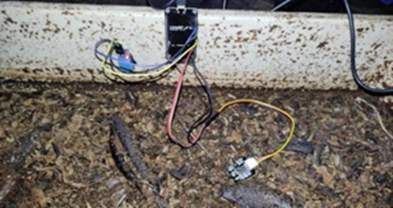Edukasi Masyarakat Jatirejo Mojosongo dalam Meningkatkan Perekonomian melalui Budidaya Maggot Berbasis IoT untuk Pengolahan Sampah Organik Educating the Jatirejo Mojosongo Community in Improving the Economy through IoT-based BSF Cultivation for Processing Organic Waste
Main Article Content
Abstract
Organic waste makes up the lion's share of solid waste generated by human activities. Therefore, organic waste management efforts are needed to help solve it. One of the efforts that can be made is using BSF larvae to decompose organic waste. BSF larvae or maggots have a high protein and fat content, a chewy texture, and the ability to secrete natural enzymes. BSF females can lay up to 400-800 eggs. After 3-4 days, the eggs will hatch into larvae and consume organic waste, including various types of organic waste such as kitchen, fruits, vegetables, fish, urban, human, and animal waste. The flexibility of BSF larval feed facilitates the cultivation process, and it becomes an ideal insect for decomposing organic waste and becomes a business field because of its fat and protein content. The method of decomposing litter using BSF larvae is quite promising because the opportunities are quite promising, but it is still completely manual. Therefore, IoT-based maggot cultivation, an innovation in maggot cultivation, is needed. IoT design is placed at the maggot breeding stage, with optimal temperature, humidity, and light intensity conditions. This breeding ground is equipped with Arduino, humidity, and temperature sensors to regulate and maintain the best state in each larval breeding process until it becomes a pupa. This design is expected to provide convenience and increase the yield of maggot cultivation.
Downloads
Article Details

This work is licensed under a Creative Commons Attribution-ShareAlike 4.0 International License.
Authors who publish with this journal agree to the following terms:
- Any article on the copyright is retained by the author(s).
- Author grant the journal, right of first publication with the work simultaneously licensed under a Creative Commons Attribution License that allows others to share work with acknowledgment of the work authors and initial publications in this journal.
- Authors are able to enter into a separate, additional contractual arrangements for non-exclusive distribution of published articles of work (eg, post-institutional repository) or publish it in a book, with acknowledgment of its initial publication in this journal.
- Authors are permitted and encouraged to post their work online (e.g., in institutional repositories or on their websites) prior to and during the submission process, as can lead to productive exchanges, as well as earlier and greater citation of published work.
- The article and any associated published material is distributed under the Creative Commons Attribution-ShareAlike 4.0 International License
References
Balato, N., Megna, M., Napolitano, M., Patruno, C. (2012). Garbage and Skin Diseases Related Risk.Occup Environd Med. 70(3) : 212 .https://doi.org/10.1136/oemed-2012-101215
Dewantoro, K. And Efendi, M., (2018). Beternak Maggot Black Soldier Fly. Jakarta: Agromedia Pustaka.
Dortmans, B., Diener, S., Verstappen Bart And Zurbrügg, C., (2017). Black Soldier Fly Biowaste Processing. Dubendorf, Switzerland: Swiss Federal Institute Of Aquatic Science And Technology.
Fahmi, M. R. (2015). Optimalisasi proses biokonversi dengan menggunakan mini-larva Hermetia illucens untuk memenuhi kebutuhan pakan ikan. Prosiding Seminar Nasional Masyarakat Biodiversitas Indonesia 1. pp.139–144. https://doi.org/10.13057/psnmbi/m010124
Hariyanto. (2021). Pengelolaan Sampah di Kota Semarang Untuk Menuju Kota Bersih. Jurnal Geografi, 11(2), 237-246. https://doi.org/10.15294/jg.v11i2.8031
Merdeka (2018). Warga Keluhkan Bau Busuk TPA Putri Cempo. https://news.republika.co.id/berita/p70zkf335/warga-keluhkan-bau-busuk-tpa-putri-cempo
Rachmawati, R., Buchori, D., Hidayat, P., Hem, S., & Fahmi, M. R. (2015). Perkembangan Dan Kandungan Nutrisi Larva Hermetia Illucens (Linnaeus) (Diptera: Stratiomyidae) Pada Bungkil Kelapa Sawit. Jurnal Entomologi Indonesia, 7(1), 28. Https://Doi.Org/10.5994/Jei.7.1.28
Rahayu, D., & Sukmono, Y. (2013). Kajian Potensi Pemanfaatan Sampah Organik Pasar Berdasarkan Karakteristiknya (Studi Kasus Pasar Segiri Kota Samarinda). Jurnal Sains &Teknologi Lingkungan, 5(2), 77-90. Https://Doi.Org/10.20885/Jstl.Vol5.Iss2.Art2
Sumantri, Arif. (2010) .Kesehatan Lingkungan dan Perspektif Islam. Jakarta: Prenada Media
Yuniarti T. dan T. Anggraeni. (2018). Dampak Tempat Pembuangan Akhir Sampah Putri Cempo Surakarta Terhadap Penyakit Kulit Pada Masyarakat Mojosongo. STIKES Mambaul’Ulum Surakarta. INFOKES, 8 (1). https://doi.org/10.47701/infokes.v8i1.193
Yuwono, A. And Mentari, P. (2018). Penggunaan Larva (Maggot) Black Soldier Fly (Bsf) Dalam Pengolahan Limbah Organik. Bogor: Seamo Biotrop. http://repositori.kemdikbud.go.id/id/eprint/23160
